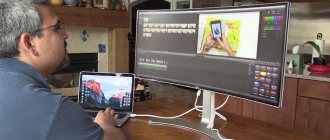The distance to the TV, depending on the diagonal, is an optimal parameter that must be taken into account, the determination of which must be approached responsibly. Doctors have long been concerned about the problem of the influence of television screens on vision. However, the practice of calculating the distance from a TV depending on its diagonal has not yet become widespread.
In the shop
The vast majority of people, starting from middle age, spend most of their free time watching TV shows and movies. This is quite understandable, given today's realities - every home has a TV (despite the assertion that it is being replaced by computers).
At what distance is it best to watch 4K TV?
4K is an abbreviation that in digital cinema and computer graphics means a resolution of 4 thousand pixels. To obtain a high-quality image, the optimal aspect ratio of the TV, monitor and projector is 16:9.
The approximate date of appearance of the technology is 2005, but it has not yet received proper distribution due to the need to purchase additional equipment and the small amount of available content.
Samsung
Meanwhile:
- Fans of new technologies convince the average consumer that the standardized scan resolution of 3840x2160 pixels allows viewing at a higher scan rate (4096x2160), while providing impressive differences in clarity, sharpness, color reproduction and even contrast.
- They also claim that, as compensation for expensive cables and ports with increased bandwidth, 4K TV can be watched from almost any distance, and the selection of dimensions here needs to be done only taking into account the room. In fact, in this case, the calculation of the required diagonal size is made only taking into account the optimal distance.
- The problem of choosing from what distance is best to look at an image is precisely the multi-pixel size. For a large screen or monitor, 2.7–3 meters is recommended. But, according to experts, in this case the human eye does not see all the required subtleties. If the distance from the screen to the viewer is less than required, 4K will clearly demonstrate the pixels, but will not give the desired clarity of the picture.
- Therefore, it is believed that a table will help determine the required distance, which is difficult for an uninitiated person to understand. Meanwhile, most buyers of new models are trying to calculate a safe distance, and a high-quality image is not the most important thing for them.
LG
Calculating the relationship between the screen diagonal and the distance from the intended place of watching TV is what the health of the eyes and the quality of the picture on the screen depend on. If we take into account only what resolution the television receiver has, and do not care about the health of human eyes, then the novelty and manufacturability of the device will not be appreciated.
What to do if TV hurts your eyes
When watching a television panel, a person blinks less often than necessary. Due to this, the cornea of the eye receives less tear fluid and dries out.
As a result, a person experiences pain and burning in the eyes and ceases to enjoy watching. To avoid this problem, you need to try to blink more often when watching TV or use special eye care products that serve as a replacement for natural tears. These include Visine, Systane and other drugs. A good solution to the problem would be to buy a projector and create a home theater. This technique displays a large screen on the wall and is considered safer for vision.
Cathode ray tube televisions
CRT, or picture tube televisions, are a type of standard device for watching television programs, in which the required distance was practically independent of the size of the screen. The required distance to the TV is also calculated based on the diagonal size. It can be easily determined by measuring the distance from the TV to the eyes (approximately where the viewer will sit), and then dividing by 5.
Viewing angle
Naturally, a distance of 2 meters will give a figure of 40 centimeters, and if you divide this figure by 2.54 (the size of an inch in centimeters), you get approximately 16 inches. If the diagonal is 32 inches, then the TV should be 4 meters away. The last CRT in these TV models, with a large screen, was released in 2014. This is due not so much to its disadvantages (of which there are relatively few), but to the fire hazard and harmful radiation.
Viewing distance for 4K Ultra HD TVs
The Full HD format is gradually losing its leadership position, which is how 4K UHD appeared. The screen resolution is 3840×2160 pixels. The price of such monitors is high, but over several years the developers have managed to reduce the cost by using alternative cheap materials. The picture quality is much higher than that of its predecessor, so many Despite their high cost, these TVs are more gentle on the eyes. This can be seen from the graph below.
You will notice that for this type of screen the distance from the eyes to it decreases.
If your budget allows, then it is worth purchasing such equipment, in addition to causing little harm to your eyesight, it will bring great pleasure when watching your favorite films and TV series.
Plasma LCD and LED TVs
Until recently, they were recommended as the newest and most technologically advanced models in the world of television production. However, if you carefully read the instructions of manufacturers and doctors, you can calculate the approximate distance here using the same principle: both of them recommend choosing the required value when purchasing, multiplying the diagonal by 5. The optimal viewing distance is selected using the formula:
- D – diagonal length;
- L – required distance to the TV diagonal;
- K is a special coefficient, the meaning of which is clear to specialists and has a value from 3 to 6 depending on how the TV diagonal should be located, whether the maximum or minimum permissible range is needed.
Recommended distances
According to this formula, the MDD (the minimum length at which the viewer should be from the screen), with D (diagonal parameters) of 70–80 inches (and 65 too), should be 5 m. Select the ratio of the diagonal to the location of the device and furniture, where the viewer will sit, much easier than choosing the diagonal of the TV, and then trying to arrange it depending on the number of meters required.
Recommendations based on specifications
The distance between the TV and the eyes is calculated correctly, taking into account several other parameters: the quality of the matrix, the declared resolution of the TV, contrast and screen formatting.
Good image quality is now determined not by the dimensions of the device, but by the quality of the matrix and other technical characteristics.
Recommended distance from floor to TV
Screen size
A common misconception when thinking about how to choose the size of a TV is that the screen diagonal size determines good visualization and there is a direct connection between them. However, even on the screens of smartphones and laptops, the image is clearer. The desired viewing angle can only be achieved by fixing a fixed distance to a relatively large screen (43 or 49 inches) or by reducing the distance to TV receivers. But in this case, even with guaranteed security, it is important to take into account the number of pixels.
Distance to TV
Screen resolution
Television does not always broadcast high-quality images. In 4K you need an app and additional accessories to get quality content, otherwise the software will correct the card's shortcomings, and if you sit too close, you may see a blurry image. The same rule works when zooming in for photos. How many pixels are needed to maintain a normal image?
For everyday use and long-term viewing, manufacturers recommend choosing high-resolution TVs. It is they, even with a relatively small diagonal, that allow the viewer not to depend on the distance. With such devices, you can allow yourself to sit closer, expand the possible viewing angle, and even activate peripheral vision, which is important for a person, to the maximum extent.
Watch a useful video on this topic below.
Security measures
As practice shows, every user can calculate the safe distance to the screen. Of course, the proposed figures are provisional. They can be used as a recommended value, and the search for the optimal distance will be carried out individually. If the TV is located on the wall, then you need to take into account at what height it is located.
The introduction of innovative technologies into the production process has made it possible to reduce excessive eye strain. They will not get tired even after watching for many hours. Many people forget that the cervical vertebrae are also involved in viewing. Doctors have made several recommendations to make viewing as safe as possible for the eyes and cervical spine:
- An excessively close distance will cause increased strain on the eye muscles.
- If the TV is too far away, then this will negatively affect the spine and vision, since the viewer will have to constantly strain to see the details.
- Installing a TV requires that the user not only correctly calculate the distance, but also select the optimal height, as well as the angle of inclination.
Another security measure is limited viewing time. You should not spend more than 2-3 hours in a row looking at the screen.
Actually, all aspects that directly or indirectly affect the distance between TV and the viewer were considered. The main criterion for determining the distance is the diagonal of the device screen. There are several recommendations for calculating the optimal value. All of them were listed above.
The good thing about modern TV models is that they are often sold with multifunctional brackets. Such stands can be adjusted to select the optimal angle, distance, and position.
Be sure to take into account the technical parameters of the TV device. The screen matrix also influences the viewer's distance from the viewing point. Think of the calculation formula as an additional recommendation, not a basic rule.
We determine the diagonal taking into account the size of the room
To correctly determine at what distance to watch TV, you must first of all proceed from the type of TV you have chosen. With the existing variety of models, it is difficult for an incompetent person to understand matrices, resolutions and other intricacies.
The main thing here is to understand one immutable truth - the larger the diagonal size you choose, the further you will have to sit from the screen. And the main importance here is not the quality of the image transmitted from the antenna, but the ability of human vision to perceive the video image.
Optimal distances
If anyone has tried to enlarge a picture from a mobile phone, strong magnification (zooming in) leads to disintegration into blurry specks of color, and no gadgets or cars can save the photo, and mobile tariffs are not to blame for this. It all depends on where the screen is. Sometimes the image up close is blurry, but if you look at it from a distance, everything will be clearly visible.
Three prohibitions
- Don't sleep with TV on . Glare from the screen disrupts the production of the hormone melatonin, which is synthesized only during sleep in complete darkness. A lack of melatonin not only threatens insomnia, but also disrupts metabolic processes in the body and increases the risk of cancer.
- Don't eat in front of the TV . In front of a blue screen, we eat more, even if we are not hungry. The fact is that while watching movies and programs, the brain is busy processing information and may be late in catching the signal that you are already full. Therefore, those who are accustomed to combining meals with watching TV eat on average 500 calories more and eat about 20 minutes longer than those who eat in silence.
- Don't turn on the TV at full volume . Excessively loud sounds can lead to hearing impairment and nervous system disorders.











